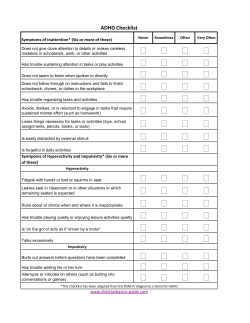
ADHD in Children NAMI Pa-Main Line September 7 2013
ADHD in Children NAMI Pa-Main Line September 7 2013 AITA SUSI MD AITASUSIMD.COM 610 308 8454 History Diagnosis Need 6 criteria in 2 different settings Ex. School and home Onset before age 7 Evidence of problems in daily living 2 basic varieties: inattentive and hyperactive Many ways to diagnose Who How Inattentive Difficulties with details follow through organization distractions remembering sustained attention listening loosing things boring tasks Hyperactive Difficulties with fidgeting climbing excessive talking interrupting “on the go” all the time staying in your seat quiet play taking turns blurting out answers Over diagnosis Normal childhood behavior is diagnosed as illness Behavioral problems are diagnosed as illness Other conditions the can look like ADHD are misdiagnosed as ADHD (anxiety, depression, mania) Provider inexperience Under diagnosis “That’s just the way she is” Daydreaming doesn’t catch attention Chaos in the household due to parental or sibling mental illness, divorce, or other difficulties can pull attention away from a child with ADHD Shame Provider inexperience Multiple diagnoses Difficult aspects of ADHD Excessive talking Disturbs others (can’t sit still, hits) Inappropriate comments Doesn’t listen Lose things Homework difficulties 1-2 yrs delayed socially because don’t know how to read social cues Engage in risky, impulsive behaviors Risk of MJ and alcohol use if ADHD is untreated Parental stress Managing calls from the school about behavioral problems Handling homework that takes a very long time to complete Books, papers, hats, etc get lost Needing to repeat yourself Difficulties with social interactions What if the parent has ADD too? Take-home message: Be patient Positive aspects of ADHD Creativity Smart Spontaneous Works quickly Good at problem solving Emotional sensitivity Exuberance Some famous people with ADHD Robin Williams Leonardo da Vinci Walt Disney Albert Einstein John Lennon Galileo Russell White Henry Winkler Greg Louganis Henry Ford Thomas Edison Jason Kidd Dustin Hoffman Dwight D. Eisenhower Michael Phelps Salvadore Dali Myths vs facts Caused by poor parenting Biological and often genetic If 1 child has it, all of my children will Not all children in a family will have it ADHD is not a disability ADHD is recognized as a disability by ADA and IDEA Medication is the only treatment There are several treatment options Kids with ADHD want to behave badly Kids with ADHD cannot be consistent in their behaviors The ADHD brain ADHD treatment Get the ADHD brain “on line” with medications that stimulate the brain Provide behavioral modifications via rewards that stimulate the brain Teach family members and teachers how to work with an ADHD brain to get the best results possible Take-home message: The ADHD brain needs to be stimulated MTA study 14-month study with 500+ children ages 7-10 4 groups of children - Medication - Behavioral therapy - Combo - Usual community care (2/3 received some meds) All 4 groups had a reduction of ADHD symptoms Significantly greater improvement in the medication and combo groups with those in the medication group doing a little bit better Take-home message: Medication is the best MTA follow-up 2 yrs after the end of the study Symptoms remained better than baseline in all groups There were no differences in symptoms between any of the groups Take-home message: It doesn’t matter what you do, but do something Risks of not treating Poor academic performance Low self-esteem Less emotional stability Less success in the future Physical injury Higher rates of substance abuse Take-home message: Less chances of living to their full potential Medications Short acting and long acting 2 basic types Amphetamines (ex. Vyvance, Adderall) Methylphenidate (ex. Conterta, Methadate) Used less often Atomoxetine (Stratera) Alpha agonists (Clonidine, Guanfacine) Behavior modifications Behavior breaks down when the demand placed on a person exceeds their ability to complete the task Want your child to develop skills to master life Learned helplessness can be the result of not taking the time to teach a child how to master life with an ADHD brain Take-home message: Pills don’t teach skills What you as a parent can do Pick 2 or 3 key areas to address Discuss these with your child and set clear boundaries with clear consequences Remain neutral when there are violations and simply institute the agreed upon consequences Maintain a loving relationship with your child Take-home message: Clear consequences delivered with neutrality Tips and ideas Use a timer 1 instruction at a time Frequent praise (ratio of 3:1 at least) Charts to check off items Rewards to stimulate the brain Provide choices Give reminders and support Take-home message: Be creative, be patient Other points to keep in mind All looks normal on the outside - inside there are things going on/not going on that we can't see Keep your cool. When there's a problem - no raised voices, no pointing ADHD kids are very needy. Recognize that & adjust to it but don’t judge Get help for yourself when you need it Take-home message: Be patient and stay calm, remember your love for your child Resources - Books Raising Boys With ADHD: Secrets for Parenting Healthy, Happy Sons by Mary Anne Richey and James Forgan The ADHD Workbook for Teens: Activities to Help You Gain Motivation and Confidence (Instant Help Book for Teens) by Lara Honos-Webb The Survival Guide for Kids with ADD or ADHD by John F. Taylor Ph.D. Taking Charge of ADHD: A Complete Authoritative Guide for Parents by R. Barkley 1-2-3 Magic Effective Discipline for Children 2-12 by Thomas W. Phelan, Ph.D. Resources – Web sites Children and Adults with ADHD www.chadd.org/ Jim Forgan Ph.D. http://jimforgan.com/ A magazine with tips for parents http://www.additudemag.com/ Further questions? Feel free to contact me Aita Susi MD aitasusimd@gmail.com 610-308-8454
© Copyright 2025





















